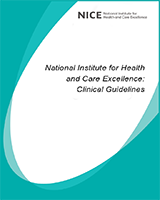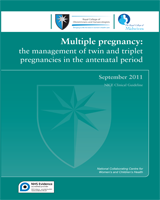Existing NICE guidance
‘Antenatal care’ (NICE clinical guideline 62)14 recommends blood pressure measurement and urinalysis for protein at each antenatal visit to screen for pre-eclampsia. Multiple pregnancy is recognised as a risk factor for pre-eclampsia and ‘Antenatal care’ (NICE clinical guideline 62)14 recommends more frequent blood pressure measurements be considered for women with multiple pregnancy.
‘Hypertension in pregnancy’ (NICE clinical guideline 107)20 addressed management of hypertensive disorders during pregnancy.
Description of included studies
Two studies were identified for inclusion for this question.115;116 The studies reported diagnostic accuracy statistics for uterine artery Doppler investigation (using resistance index, notching, pulsatility index and combinations of these measures) in screening for pre-eclampsia in twin pregnancies. One study116 used transvaginal scanning at 22–24 weeks of gestation: the other did not report the method of scanning used, but the test was undertaken at 18–24 weeks of gestation (median 21 weeks).115 One study was conducted in England116 and the other in Germany.115
No studies were identified which reported screening for gestational hypertension or for screening in triplet pregnancies. No studies were identified which reported on maternal history, blood pressure, maternal blood tests, maternal urine tests, integrated tests or composite screening strategies.
The prevalence rate of pre-eclampsia in the first study was 8.6% and in the second study 6.0%: these rates are higher than in general pregnant populations, supporting the finding that twin pregnancy is associated with an increased risk of pre-eclampsia.
Published health economic evidence
No published health economic evidence was identified and this question was not prioritised for health economic analysis.
Evidence profiles
Evidence profiles for this question are presented in .
GRADE summary of findings for screening tests to detect hypertension in twin pregnancies.
Evidence statement
Evidence was reported for uterine artery Doppler ultrasound for predicting the onset of pre-eclampsia in twin pregnancies. The evidence was mainly very low in quality.
The tests varied in terms of diagnostic accuracy. Using the pulsatility index with bilateral notching resulted in the strongest LR+ statistic, highest specificity and highest predictive values (low quality evidence). The pulsatility index alone resulted in the strongest LR− statistic (low quality evidence). The sensitivity of all tests was low.
No studies were identified that reported on screening for gestational hypertension in twin pregnancies or that reported on screening for any hypertensive disorders in triplet pregnancies. No studies were identified that used maternal history, blood pressure, maternal blood tests, maternal urine tests, integrated tests or composite screening strategies to predict hypertension in multiple pregnancy.
Evidence to recommendations
Relative value placed on the outcomes considered
Screening for hypertensive disorders in pregnancy is important as they can result in maternal and neonatal morbidity or mortality.
Sensitivity is the proportion of women who went on to develop hypertension who were predicted to develop hypertension (true positive). One hundred minus sensitivity (100 – sensitivity) shows how many of these pregnancies were predicted to be normotensive (false negative).
Specificity is the proportion of women who remained normotensive during pregnancy who were predicted to be normotensive (true negative). One hundred minus specificity (100 – specificity) shows how many of these women were predicted to develop hypertension during pregnancy (false positive).
PPV is the proportion of women who were predicted to be hypertensive who went on to develop hypertension. One hundred minus PPV (100 – PPV) shows how many of these women were actually found to be normotensive.
NPV is the proportion of women who were predicted to be normotensive who remained normotensive. One hundred minus NPV (100 – NPV) shows how many of these women were actually found to be hypertensive.
The positive likelihood ratio (LR+) shows how much the odds of a woman being hypertensive during pregnancy increase when hypertension is predicted. The negative likelihood ratio (LR−) shows how much the odds of a pregnancy being hypertensive decrease when a normotensive pregnancy is predicted.
The GDG’s view was that focusing on sensitivity and likelihood ratios would allow them to make the most effective recommendations for this review question.
Trade-off between clinical benefits and harms
It is important that a screening strategy allows women who will develop hypertension in pregnancy to be identified (high number of true positives). It is also important that women who are reassured that they will remain normotensive do not go on to develop hypertension in pregnancy (low number of false negatives). ‘Antenatal care’ (NICE clinical guideline 62)14 states that blood pressure measurement and urinalysis for protein should be carried out at each antenatal visit to screen for pre-eclampsia. It also recommends that, because multiple pregnancy is a risk factor for pre-eclampsia, more frequent blood pressure measurements should be considered, and goes on to state that although there is a great deal of material published on alternative screening methods for pre-eclampsia (alternative to blood pressure monitoring, urinalysis for proteinuria and enquiring about symptoms such as severe headache, visual problems, epigastric pain, vomiting or sudden swelling of face, hands or feet), none of these has satisfactory sensitivity and specificity, and therefore they are not recommended.
Of the evidence reviewed for screening for hypertension in twin and triplet pregnancies, uterine artery Doppler shows promise (particularly pulsatility index more than the 95th centile), as its high NPV excludes risk (96% of women who were predicted to be normotensive remained normotensive). However, it is currently not a sensitive screening test, and therefore the GDG does not recommend its use in predicting hypertension in twin and triplet pregnancies.
Trade-off between net health benefits and resource use
All of the available evidence (which was limited to two studies) refers to ultrasound methods of screening. The GDG’s view was that its recommendations would not lead to a change in practice, but the GDG acknowledges that women with twin or triplet pregnancies come into contact with healthcare professionals more often that those with singleton pregnancies. This extra contact will result in more frequent blood pressure monitoring, urine testing and so on, and this will lead to increased costs of antenatal care compared to a singleton pregnancy.
Quality of evidence
Very low quality evidence was found for using resistance index of more than 95th centile alone and very low to low quality evidence was found for using unilateral or bilateral notching alone. Low quality evidence was found for using resistance index of more than 95th centile with unilateral or bilateral notching and for using pulsatility index more than 95th centile alone and with bilateral notching.
Other considerations
No evidence was identified that allowed the GDG to consider different screening strategies for monochorionic and dichorionic pregnancies. No evidence was identified for screening in triplet pregnancies. The evidence for screening in twins is limited and heterogeneous. The evidence for uterine artery Doppler in twin and triplet pregnancies is limited. The NICE guidance for routine antenatal care recommends increased blood pressure testing and urinalysis at every contact with a healthcare professional from 24 weeks.
Multiple pregnancy is a moderate risk factor for the development of pre-eclampsia during pregnancy. Therefore, the GDG recommended that women with twin or triplet pregnancies, who have any of the other moderate risk factors for pre-eclampsia (first pregnancy, age 40 years or older, pregnancy interval of more than 10 years, BMI of 35 kg/m2 or more at first visit, or family history of pre-eclampsia), should be offered a daily aspirin dose in accordance with ‘Hypertension in pregnancy’ (NICE clinical guideline 107).20


